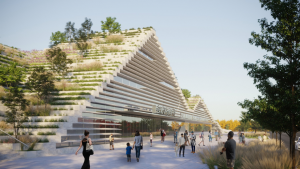
Mexican architect Frida Escobedo is at the height of her career, which includes founding two studios, multiple collaborations, recognitions and awards. Not one to ascribe to architectural trends, Escobedo is more interested in combining her own brand of modernism with populist traditions. Her body of work, which ranges from public plazas to hotels, is a culmination of bold, raw designs that refuse to be pigeonholed into one style in particular. Here, she offers her point of view on architectural practice and current subjects pervading the industry right now.
Why did you get into architecture?
It was almost accidental. I made up my mind a week before the admission test at the University. I knew I wanted to do something related to art or design but wasn’t completely sure at that time.
There is a big shift happening in your industry that questions the architect’s role in society and causes some to assign labels to different types of architects. What type of architect would you describe yourself as?
I am not sure…labels are always so dangerous. I guess I would like to be a congruous person, a person that is aware of the time and place she lives in. I try to remember that not only as an architect but also as an individual. The tiny, everyday actions are the ones I feel can have more impact.
Which projects excite you the most?
The ones that represent a challenge. Kersten Geers once told me it is important to “stay slippery”, to not get too comfortable or easy to define. That keeps you growing and learning.
Some argue that public interest architecture is an independent profession – a path that architects can choose to follow or not – and others believe that all architecture should be public-minded/humanitarian. Where do you stand on this subject?
I believe that there is a chance to change our environment in every project, regardless of the scale or how public or private the commission is. It is not only what we build but also how we build it that has a social impact. Choosing materials has an impact on local producers/manufacturers, thinking about materials that will age well are always important considerations on each project. It is also important to remember that architecture is about the relationship between interior or exterior, public or private. Gated communities are proof that private spaces have an impact on the urban space. Social housing is also proof of that.
Do you believe architecture can change lives or help people?
Yes, for good and bad.
As a sense of social responsibility is beginning to shape the practice of architecture, there seems to be a lean toward collaboration with experts from other fields. Are you an advocate of this and if yes, why?
Architecture has always been a collaborative field. I find it impossible to think that we don’t need to rely on many other disciplines to do our job. What is interesting now is the very own definition of architecture (as many other practices) is blurry. Spatial practices can help find solutions to very complex problems in ways that we haven’t thought before.





